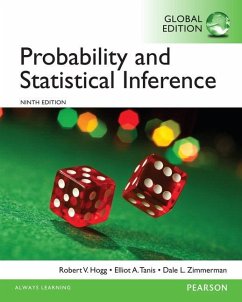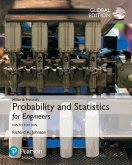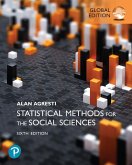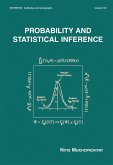For a one- or two-semester course; calculus background presumed, no previous study of probability or statistics is required.
Written by three veteran statisticians, this applied introduction to probability and statistics emphasizes the existence of variation in almost every process, and how the study of probability and statistics helps us understand this variation. Designed for students with a background in calculus, this book continues to reinforce basic mathematical concepts with numerous real-world examples and applications to illustrate the relevance of key concepts. Product Description
For a one- or two-semester course; calculus background presumed, no previous study of probability or statistics is required.
Written by three veteran statisticians, this applied introduction to probability and statistics emphasizes the existence of variation in almost every process, and how the study of probability and statistics helps us understand this variation. Designed for students with a background in calculus, this book continues to reinforce basic mathematical concepts with numerous real-world examples and applications to illustrate the relevance of key concepts. Features + Benefits
The new organization presents information in a logical, easy-to-grasp sequence, incorporating the latest trends and scholarship in the field of probability and statistical inference. Balanced coverage of probability and statistics includes:
Five chapters that focus on probability and probability distributions, including discrete data, order statistics, multivariate distributions, and normal distribution.
The text’s second half emphasizes statistics and statistical inference, including estimation, Bayesian estimation, tests of statistical hypotheses, and methods for quality improvement.
The student-friendly approach reinforces basic mathematical concepts, requiring just a calculus background.
Application-oriented content features real-world scenarios in the exercises and examples, with applications in the areas of biology, economics, health, sociology, and sports.
Integration of computer-based data and applications showcases the increased use of data and computers for calculating probabilities, analyzing data, solving problems, and conducting simulations.
Historical vignettes at the end of each chapter outline the origin of the greatest accomplishments in the field of statistics, adding enrichment to the course.
All of the data sets are available online at the Pearson Math & Stats Resources website in formats for use with most statistical software packages; enhanced figures from the text and Maple examples are also available.
Preface
Prologue
1. Probability
1.1 Properties of Probability
1.2 Methods of Enumeration
1.3 Conditional Probability
1.4 Independent Events
1.5 Bayes' Theorem
2. Discrete Distributions
2.1 Random Variables of the Discrete Type
2.2 Mathematical Expectation
2.3 Special Mathematical Expectations
2.4 The Binomial Distribution
2.5 The Negative Binomial Distribution
2.6 The Poisson Distribution
3. Continuous Distributions
3.1 Random Variables of the Continuous Type
3.2 The Exponential, Gamma, and Chi-Square Distributions
3.3 The Normal Distribution
3.4 Additional Models
4. Bivariate Distributions
4.1 Bivariate Distributions of the Discrete Type
4.2 The Correlation Coe±cient
4.3 Conditional Distributions
4.4 Bivariate Distributions of the Continuous Type
4.5 The Bivariate Normal Distribution
5. Distributions of Functions of Random Variables
5.1 Functions of One Random Variable
5.2 Transformations of Two Random Variables
5.3 Several Random Variables
5.4 The Moment-Generating Function Technique
5.5 Random Functions Associated with Normal Distributions
5.6 The Central Limit Theorem
5.7 Approximations for Discrete Distributions
5.8 Chebyshev's Inequality and Convergence in Probability
5.9 Limiting Moment-Generating Functions
6. Point Estimation
6.1 Descriptive Statistics
6.2 Exploratory Data Analysis
6.3 Order Statistics
6.4 Maximum Likelihood Estimation
6.5 A Simple Regression Problem
6.6 Asymptotic Distributions of Maximum Likelihood Estimators
6.7 Su±cient Statistics
6.8 Bayesian Estimation
6.9 More Bayesian Concepts
7. Interval Estimation
7.1 Confidence Intervals for Means
7.2 Confidence Intervals for the Di®erence of Two Means
7.3 Confidence Intervals for Proportions
7.4 Sample Size
7.5 Distribution-Free Confidence Intervals for Percentiles
7.6 More Regression
7.7 Resampling Methods
8. Tests of Statistical Hypotheses
8.1 Tests about One Mean
8.2 Tests of the Equality of Two Means
8.3 Tests about Proportions
8.4 The Wilcoxon Tests
8.5 Power of a Statistical Test
8.6 Best Critical Regions
8.7 Likelihood Ratio Tests
9. More Tests
9.1 Chi-Square Goodness-of-Fit Tests
9.2 Contingency Tables
9.3 One-Factor Analysis of Variance
9.4 Two-Way Analysis of Variance
9.5 General Factorial and 2k Factorial Designs
9.6 Tests Concerning Regression and Correlation
9.7 Statistical Quality Control
Epilogue
A. References
B. Tables
C. Answers to Odd-Numbered Exercises
D. Review of Selected Mathematical Techniques
Index
For a one- or two-semester course; calculus background presumed, no previous study of probability or statistics is required. Written by three veteran statisticians, this applied introduction to probability and statistics emphasizes the existence of variation in almost every process, and how the study of probability and statistics helps us understand this variation. Designed for students with a background in calculus, this book continues to reinforce basic mathematical concepts with numerous real-world examples and applications to illustrate the relevance of key concepts.
Written by three veteran statisticians, this applied introduction to probability and statistics emphasizes the existence of variation in almost every process, and how the study of probability and statistics helps us understand this variation. Designed for students with a background in calculus, this book continues to reinforce basic mathematical concepts with numerous real-world examples and applications to illustrate the relevance of key concepts. Product Description
For a one- or two-semester course; calculus background presumed, no previous study of probability or statistics is required.
Written by three veteran statisticians, this applied introduction to probability and statistics emphasizes the existence of variation in almost every process, and how the study of probability and statistics helps us understand this variation. Designed for students with a background in calculus, this book continues to reinforce basic mathematical concepts with numerous real-world examples and applications to illustrate the relevance of key concepts. Features + Benefits
The new organization presents information in a logical, easy-to-grasp sequence, incorporating the latest trends and scholarship in the field of probability and statistical inference. Balanced coverage of probability and statistics includes:
Five chapters that focus on probability and probability distributions, including discrete data, order statistics, multivariate distributions, and normal distribution.
The text’s second half emphasizes statistics and statistical inference, including estimation, Bayesian estimation, tests of statistical hypotheses, and methods for quality improvement.
The student-friendly approach reinforces basic mathematical concepts, requiring just a calculus background.
Application-oriented content features real-world scenarios in the exercises and examples, with applications in the areas of biology, economics, health, sociology, and sports.
Integration of computer-based data and applications showcases the increased use of data and computers for calculating probabilities, analyzing data, solving problems, and conducting simulations.
Historical vignettes at the end of each chapter outline the origin of the greatest accomplishments in the field of statistics, adding enrichment to the course.
All of the data sets are available online at the Pearson Math & Stats Resources website in formats for use with most statistical software packages; enhanced figures from the text and Maple examples are also available.
Preface
Prologue
1. Probability
1.1 Properties of Probability
1.2 Methods of Enumeration
1.3 Conditional Probability
1.4 Independent Events
1.5 Bayes' Theorem
2. Discrete Distributions
2.1 Random Variables of the Discrete Type
2.2 Mathematical Expectation
2.3 Special Mathematical Expectations
2.4 The Binomial Distribution
2.5 The Negative Binomial Distribution
2.6 The Poisson Distribution
3. Continuous Distributions
3.1 Random Variables of the Continuous Type
3.2 The Exponential, Gamma, and Chi-Square Distributions
3.3 The Normal Distribution
3.4 Additional Models
4. Bivariate Distributions
4.1 Bivariate Distributions of the Discrete Type
4.2 The Correlation Coe±cient
4.3 Conditional Distributions
4.4 Bivariate Distributions of the Continuous Type
4.5 The Bivariate Normal Distribution
5. Distributions of Functions of Random Variables
5.1 Functions of One Random Variable
5.2 Transformations of Two Random Variables
5.3 Several Random Variables
5.4 The Moment-Generating Function Technique
5.5 Random Functions Associated with Normal Distributions
5.6 The Central Limit Theorem
5.7 Approximations for Discrete Distributions
5.8 Chebyshev's Inequality and Convergence in Probability
5.9 Limiting Moment-Generating Functions
6. Point Estimation
6.1 Descriptive Statistics
6.2 Exploratory Data Analysis
6.3 Order Statistics
6.4 Maximum Likelihood Estimation
6.5 A Simple Regression Problem
6.6 Asymptotic Distributions of Maximum Likelihood Estimators
6.7 Su±cient Statistics
6.8 Bayesian Estimation
6.9 More Bayesian Concepts
7. Interval Estimation
7.1 Confidence Intervals for Means
7.2 Confidence Intervals for the Di®erence of Two Means
7.3 Confidence Intervals for Proportions
7.4 Sample Size
7.5 Distribution-Free Confidence Intervals for Percentiles
7.6 More Regression
7.7 Resampling Methods
8. Tests of Statistical Hypotheses
8.1 Tests about One Mean
8.2 Tests of the Equality of Two Means
8.3 Tests about Proportions
8.4 The Wilcoxon Tests
8.5 Power of a Statistical Test
8.6 Best Critical Regions
8.7 Likelihood Ratio Tests
9. More Tests
9.1 Chi-Square Goodness-of-Fit Tests
9.2 Contingency Tables
9.3 One-Factor Analysis of Variance
9.4 Two-Way Analysis of Variance
9.5 General Factorial and 2k Factorial Designs
9.6 Tests Concerning Regression and Correlation
9.7 Statistical Quality Control
Epilogue
A. References
B. Tables
C. Answers to Odd-Numbered Exercises
D. Review of Selected Mathematical Techniques
Index
For a one- or two-semester course; calculus background presumed, no previous study of probability or statistics is required. Written by three veteran statisticians, this applied introduction to probability and statistics emphasizes the existence of variation in almost every process, and how the study of probability and statistics helps us understand this variation. Designed for students with a background in calculus, this book continues to reinforce basic mathematical concepts with numerous real-world examples and applications to illustrate the relevance of key concepts.








